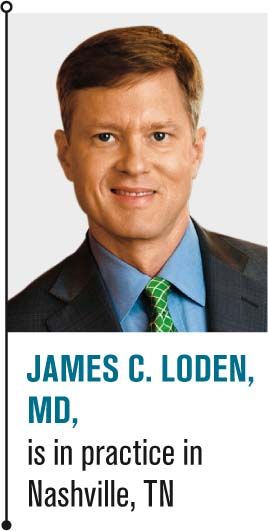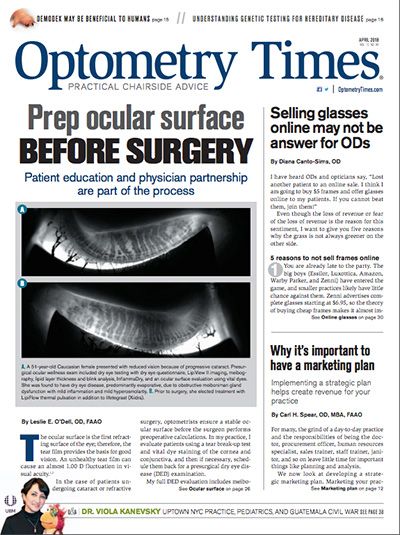5 features of successful comanagement
A comanaging MD discusses what five traits should be part of any OD-MD comanaging relationship. Setting patient expectations on both ends is the underlying framework.

In my Nashville practice, my colleagues and I successfully comanage surgical patients with a large network of referring optometrists. Over the years, I have learned what steps ophthalmologists and optometrists should take to set their relationships up for success. The underlying theme is the setting of realistic expectations.
Preframe the relationship
“Preframing” is a way of setting patients up so that they know exactly what to expect from their preoperative exams and procedures. As a part of setting these expectations, ODs and MDs explain where patients will be seen for their follow-up examinations. Having a specific conversation in advance is a much more effective method of communication, rather than having to “reframe” the patient’s expectations later.
Related: Cataract Co-management-an OD’s perspective
For example, the patient’s optometrist might have a conversation like this: “I am sending you to see Dr. Loden. I am confident he will do a great job and give you the outcome you are looking for. When you go to the clinic, he and his staff will perform several tests, he will discuss laser surgery, and he will make a recommendation based on what is best for you. I know you have worn monovision contact lenses for years, and monovision can work well with cataract surgery. I will recommend to Dr. Loden that you proceed with monovision cataract surgery, but he will discuss that more after he has the results of the preoperative testing. After the surgery, I will see you back here for the one-day postoperative exam.”

With that as background, here are five key characteristics to successful comanagement.
1. It is legal and ethical
According to the Medicare guidelines, payments cannot be made for referrals. True comanagement requires that care transfer from the optometrist to the surgeon and from the surgeon back to the optometrist, with both parties participating in the care.
For premium intraocular lens (IOL) surgery, which typically involves higher fees for both the surgeon and the optometrist, additional services must be provided to justify the additional fees. For example, for potential premium IOL patients, I like to see more preoperative tests performed during their prior care.
I perform laser arcuate incisions for patients with >0.50 D of corneal astigmatism, and I choose a toric IOL for those with >1.25 D of cylinder. Therefore, my network of optometrists referring patients for refractive cataract surgery must be able to determine how much corneal astigmatism they have via corneal topography. Topography is also useful for evaluating the position of a toric lens postoperatively. If a lens appears to be >5° off axis after surgery, I want to know. A slit-lamp with a rotating axis beam is the bare minimum to perform this function.
2. It benefits the patient
Comanagement, most importantly, is a collaborative arrangement that benefits the patient. By teaming up with the patient’s long-term doctor, I can provide better care. The optometrist lets me know about the patient with chronic dry eye and the one who loves her contact lens monovision. I am prepared for the difficult-to-please patient who needed to have his past three pairs of glasses remade.

In appropriate cataract patients, I use Johnson & Johnson Vision Tecnis Symfony extended depth of focus (EDOF) IOL for correcting presbyopia. I have found that the technology offers patients what is a natural range of visional with minimal disadvantages. I also use Alcon AcrySof IQ ReStor +2.50 D and Bausch + Lomb Crystalens AO.
For patients who require strong near vision, I might consider a multifocal implant. In that case, I would rely on the optometrist to understand the patient’s experience with multifocal contact lenses, which I find to be an excellent predictor of success with multifocal IOLs.
Related: The latest tool for photo-refractive comanagement
I also rely on comanaging doctors to flag a clinical indication for a recommendation against a premium procedure. It is important to note that, in the absence of a clinical finding, I am legally obligated to offer patients the full range of services for which they are qualified.
3. It reinforces patients’ trust in providers
A collaborative relationship between surgeons and optometrists shows patients that we work as a team to prioritize their care. Comanaging doctors should speak with authority on the options of advanced technology like laser cataract surgery and premium IOLs.
This goes back to my opening about preframing the surgical visit so that the patient knows exactly what to expect. A patient should never be presented with this overwhelming information for the first time at the surgeon’s office.
Sending a cohesive message enhances patients’ confidence and makes it easier for me to send them back to the referring optometrist. For example, consider a situation in which the optometrist tells a patient he might have a cataract but never mentions astigmatism. If I confirm the patient’s corneal astigmatism and begin discussing the benefits of a toric IOL combined with laser surgery, he will think the optometrist does not know much about cataract surgery. The patient may then be less than enthusiastic about returning for postoperative care.
4. It is collegial and communicative
It is very important that ophthalmologists be respectful, responsive, and accessible to referring optometrists. Prompt perioperative communication is key; surgeons should let optometrists know how the procedure went, and optometrists should communicate back information about the patient’s satisfaction and refraction after the first eye.
Related: Managing the non-surgical aspect of comanagement
Such information helps my second-eye decision making. For example, in a toric IOL patient who is not completely happy, good communication helps me determine if she needs a LASIK touch up, Nd:YAG surgery, or a repositioning of the lens.

5. It is enjoyable, not just obligatory
In my experience, ophthalmologists and optometrists who enjoy continually learning about the nuances of refractive cataract surgery are best positioned to effectively comanage premium IOL procedures. For example, EDOF lens technology may be considered in some cataract patients who may have been ruled out as candidates for premium lenses in the past. This technology is an example of one that requires a different approach for both surgeons and optometrists.
Moving forward
Staying on top of advancements and the ever-evolving clinical pearls surrounding refractive cataract surgery, advanced IOLs, and laser procedures takes time and effort and is essential to ideal comanagement. Optometrists and surgeons who participate in the latest innovations and share their knowledge can experience immensely enjoyable partnerships and-more importantly-provide the best care to their patients.
Newsletter
Want more insights like this? Subscribe to Optometry Times and get clinical pearls and practice tips delivered straight to your inbox.
